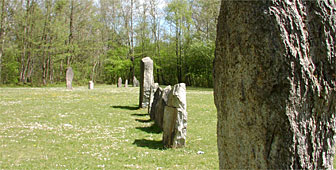Discovering the mysteries of Yverdon

An enigmatic cloud will hover just off the shore of Yverdon-les-Bains during Expo.02. It is a fitting symbol for a town known for mysteries.
The artificial cloud, created by shooting tiny drops of lake water through thousands of jets, will be the centrepiece of the Yverdon-les-Bains exhibition site, which has chosen “Me and the Universe” as its main theme.
One could say the people of Yverdon-les-Bains have been trying to figure out the mysteries of the cosmos for thousands of years.
The first piece of evidence is only a 15-minute walk outside the city centre. In a forest clearing are rows and semi-circles of large stone slabs.
Megaliths
The Menhir stones, some as tall as 4.5 metres, are the most impressive megalithic monuments in Switzerland, and resemble the stone formations of Carnac in France’s Brittany region.
“We don’t know that much about them,” says Daniel Oester, of the Yverdon-les-Bains tourist office. “But we do know that they were erected in the Neolithic age, about 5,000 years ago. We suppose that they were used for cult purposes.”
The Neolithic inhabitants took the large stones that had been carried to the area by glaciers during the last ice age and carved rough human shapes out of them, and placed them in rows and semi-circles, making scientists believe it was the site of pre-historic religious rituals.
But despite their archaeological importance, visitors usually have the site to themselves, and can let their imaginations run wild as to the purpose of the stone formations.
The tourist office does not actively advertise the site. “It’s difficult to promote if even scientists can’t say exactly why (the stones) were erected, so we can’t give visitors much information about them.”
Back at the Expo site, visitors will have the chance to walk across a footbridge connecting the shore with the artificial cloud. Once in the cloud, they can saddle up to a bar to taste different kinds of mineral water.
Source of well-being
The water of Yverdon-les-Bains has been a mysterious source of well being for millennia, and the spa and health centre is still the town’s main attraction.
“The water of Yverdon-les-Bains was discovered during the Roman period. And it is still important today,” says Claude Ogay, director of the spa.
“The water from the thermal springs is always more than 20 degrees, and its physical and chemical properties including its high sulphur content mean it can be used to treat different diseases,” says Ogay.
Today, the spa and its adjoining clinic specialise in the treatment of rheumatic and neurological ailments and the after-effects of bone surgery.
The most unexpected mystery of Yverdon-les-Bains is a museum dedicated to science fiction, located in the heart of the old town.
House of Elsewhere
The “Maison d’Ailleurs” (House of Elsewhere) boasts 40,000 books – many of them rare copies. They are “related to science fiction, utopia and extraordinary journeys” as museum curator, Patrick Gyger describes the books in the collection.
Gyger says the history of science fiction goes back to the second century when writers tried to explain how people went to the moon. Modern sci-fi began in 1818 when Mary Shelley published Frankenstein, inspired during her stay on Lake Geneva.
The collection that gave the museum its start belonged to the Frenchman, Pierre Versins, who was an inmate at Auschwitz and received his first sci-fi book while recovering at the Swiss health resort of Leysin.
The museum also houses temporary art exhibits relating to science fiction or fantasy, and one room is dedicated to the sinister creations of Swiss artist, H.R. Giger, the man behind the monsters in the Hollywood “Alien” films.
But the museum mainly serves as a research institution, and was even asked by the European Space Agency to search for ideas in its collection that could be transformed from the realm of fiction into fact.
“They think we might contribute in finding ideas in science fiction books, novels, imagery, whatever,” explains Gyger. “I think we can contribute because we can popularise science techniques and technologies and make them sexy for a general public.”
Eccentric cabins
The last mystery of Yverdon-les-Bains is a row of tidy and very tiny cabins lining a small road close to the port and the Expo site. They serve as weekend residences and when it comes to their eccentric appearances, it’s clear the imagination of their owners have run wild.
Some seem to have been torn away from the beaches of the North Sea, and yet another, with its whitewashed exterior, could have been lifted from Panama’s Caribbean coast. A dark brown hut has been dubbed Kenya, and garden gnomes guard another.
The cabins are not on the list of Yverdon’s official Expo attractions, but they are worth a visit for people inspired by the theme, “Me and the Universe”.
by Dale Bechtel
Visiting Yverdon-les-Bains
Switzerland’s national exhibition, Expo.02 begins on May 15 and runs until October at Yverdon-les-Bains and three other towns in western Switzerland’s “Three Lakes Region”. A pleasant walk beyond the picturesque old town follows Rue Pêcheurs in the direction of the lake. Nearing the port, turn right onto Avenue Iris, with its small cabins. It is only a couple hundred metres to a spacious treed park on the lakeshore, ideal for a picnic. From here, a path leads through the woods to the Menhir stone formations. The Maison d’Ailleurs is currently presenting a temporary exhibition of the fantasy works of the British artist, Patrick Woodroffe. It is open afternoons from Wednesday to Sunday. The town’s spa also boasts a four star hotel and restaurant.

In compliance with the JTI standards
More: SWI swissinfo.ch certified by the Journalism Trust Initiative








You can find an overview of ongoing debates with our journalists here . Please join us!
If you want to start a conversation about a topic raised in this article or want to report factual errors, email us at english@swissinfo.ch.